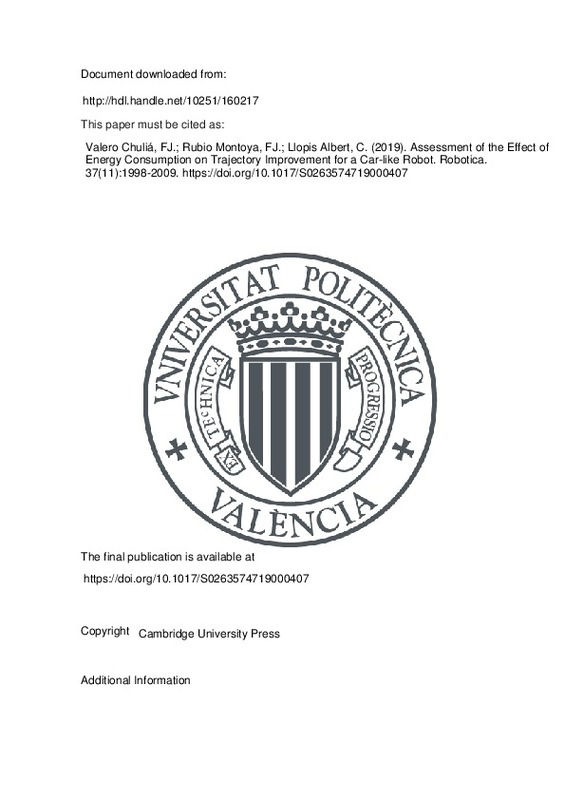JavaScript is disabled for your browser. Some features of this site may not work without it.
Buscar en RiuNet
Listar
Mi cuenta
Estadísticas
Ayuda RiuNet
Admin. UPV
Assessment of the Effect of Energy Consumption on Trajectory Improvement for a Car-like Robot
Mostrar el registro sencillo del ítem
Ficheros en el ítem
| dc.contributor.author | Valero Chuliá, Francisco José
|
es_ES |
| dc.contributor.author | Rubio Montoya, Francisco José
|
es_ES |
| dc.contributor.author | Llopis Albert, Carlos
|
es_ES |
| dc.date.accessioned | 2021-01-29T04:31:08Z | |
| dc.date.available | 2021-01-29T04:31:08Z | |
| dc.date.issued | 2019-11 | es_ES |
| dc.identifier.issn | 0263-5747 | es_ES |
| dc.identifier.uri | http://hdl.handle.net/10251/160217 | |
| dc.description.abstract | [EN] Reducing the energy consumed by a car-like mobile robot makes it possible to move at a lower cost, yet it takes more working time. This paper proposes an optimization algorithm for trajectories with optimal times and analyzes the consequences of restricting the energy consumed on the trajectory obtained for a car-like robot. When modeling the dynamic behavior of the vehicle, it is necessary to consider its inertial parameters, the behavior of the motor, and the basic properties of the tire in its interaction with the ground. To obtain collision-free, minimum-time trajectories quadratic sequential optimization techniques are used, where the objective function is the time taken by the robot to move between two given configurations. This is subject to constraints relating to the vehicle and tires as well as the energy consumed, which is the basis for this paper. We work with a real random distribution of consumed energy values following a normal Gaussian distribution in order to analyze its influence on the trajectories obtained by the vehicle. The energy consumed, the time taken, the maximum velocity reached, and the distance traveled are analyzed in order to characterize the properties of the trajectories obtained. The proposed algorithm has been applied to 101 examples, showing that the computational times needed to obtain the solutions are always lower than those required to realize the trajectories. The results obtained allow us to reach conclusions about the energy efficiency of the trajectories. | es_ES |
| dc.language | Inglés | es_ES |
| dc.publisher | Cambridge University Press | es_ES |
| dc.relation.ispartof | Robotica | es_ES |
| dc.rights | Reconocimiento - No comercial - Sin obra derivada (by-nc-nd) | es_ES |
| dc.subject | Energy consumed | es_ES |
| dc.subject | Car-like mobile robot | es_ES |
| dc.subject | Robot dynamics | es_ES |
| dc.subject | Tire interaction | es_ES |
| dc.subject | Minimum-time trajectory | es_ES |
| dc.subject | Collision-free trajectory | es_ES |
| dc.subject | Working parameters | es_ES |
| dc.subject.classification | INGENIERIA MECANICA | es_ES |
| dc.title | Assessment of the Effect of Energy Consumption on Trajectory Improvement for a Car-like Robot | es_ES |
| dc.type | Artículo | es_ES |
| dc.identifier.doi | 10.1017/S0263574719000407 | es_ES |
| dc.rights.accessRights | Abierto | es_ES |
| dc.contributor.affiliation | Universitat Politècnica de València. Departamento de Ingeniería Mecánica y de Materiales - Departament d'Enginyeria Mecànica i de Materials | es_ES |
| dc.description.bibliographicCitation | Valero Chuliá, FJ.; Rubio Montoya, FJ.; Llopis Albert, C. (2019). Assessment of the Effect of Energy Consumption on Trajectory Improvement for a Car-like Robot. Robotica. 37(11):1998-2009. https://doi.org/10.1017/S0263574719000407 | es_ES |
| dc.description.accrualMethod | S | es_ES |
| dc.relation.publisherversion | https://doi.org/10.1017/S0263574719000407 | es_ES |
| dc.description.upvformatpinicio | 1998 | es_ES |
| dc.description.upvformatpfin | 2009 | es_ES |
| dc.type.version | info:eu-repo/semantics/publishedVersion | es_ES |
| dc.description.volume | 37 | es_ES |
| dc.description.issue | 11 | es_ES |
| dc.relation.pasarela | S\395064 | es_ES |
| dc.description.references | Rubio, F., Valero, F., Lluís Sunyer, J., & Garrido, A. (2010). The simultaneous algorithm and the best interpolation function for trajectory planning. Industrial Robot: An International Journal, 37(5), 441-451. doi:10.1108/01439911011063263 | es_ES |
| dc.description.references | Liu, S., & Sun, D. (2014). Minimizing Energy Consumption of Wheeled Mobile Robots via Optimal Motion Planning. IEEE/ASME Transactions on Mechatronics, 19(2), 401-411. doi:10.1109/tmech.2013.2241777 | es_ES |
| dc.description.references | Renny Simba, K., Uchiyama, N., & Sano, S. (2016). Real-time smooth trajectory generation for nonholonomic mobile robots using Bézier curves. Robotics and Computer-Integrated Manufacturing, 41, 31-42. doi:10.1016/j.rcim.2016.02.002 | es_ES |







![[Cerrado]](/themes/UPV/images/candado.png)

